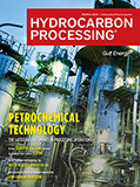Drivers
HP Reliability: TAMU Turbo and Pump symposiums still leading
Beginning in 1971, the Turbomachinery Laboratory of Texas A&M University (TAMU) organized the first of now 41 consecutive annual turbomachinery symposiums, now known as the TAMU Turbo. In 1984, Texas ..
Reliability and maintenance: The path to world-class performance
HPI companies in a progressive culture strive for failure-free operations with defect elimination and uninterrupted operation.
HP Reliability: Upgrade the design of vertical, multistage centrifugal pumps in low-temperature services
The overall mechanical design of most API-style vertical-column pumps (Fig. 1) comes close to meeting the expectations of modern pump users. Such pumps are often equipped with self oil-lubricated bear..
HP Reliability: Closed-oil-mist systems and maintenance cost avoidance
A recent Hydrocarbon Processing (HP) article conveyed an industry finding that dates back several decades: Oil mist successfully lubricates operating machinery, protects and preserves standby equipmen..
HP Engineering Case Histories: Case 70: Twenty rules for troubleshooting
In previous Engineering Case History columns, I have discussed checklists and their value in avoiding errors during startups. While the rules cannot replace common sense or a logical and methodical ap..
Modernize your compressor lube- and seal-oil systems
Each pipe or control line should be traced to its origin, the design intent must be well understood, and all owner-purchaser questions answered by the vendor-manufacturer.
Consider new developments for variable-speed electric motors
New challenges, recent developments, the latest mechanical issues and main reliability factors for large variable-speed electric motor drivers in HPI plants are presented here.
Improve performance monitoring of your turbomachinery
This case study documents the performance variables to consider and apply when monitoring and tracking the efficiency deterioration for a steam turbine using DSs in a PI process book.
Case history: Improve refrigeration compressor performance
This case examines the mechanical distress and performance deterioration of a critical refrigeration compressor that was installed at a world-scale petrochemicals complex.
Apply new guidelines to select compressors for low-temperature service
The writer calls on design and process engineers to take extra precautions when selecting and sizing their reciprocating compressors for low-temperature gas service.

- India receives fuel oil cargo in Russian SCF tanker after brief halt 4/26
- Biden administration (U.S.) to release SAF tax credit model 4/26
- Boeing, Wagner advance Australia’s SAF Industry 4/26
- S-Oil expects Q2 refining margins to remain steady then trend upward 4/26
- Vitol to charter supertankers from U.S. to Nigeria's Dangote refinery 4/26
- Refiner Valero beats profit estimates on resilient demand, tight supplies 4/26




